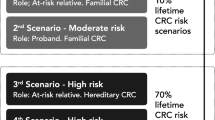Abstract
Background: Sufficient evidence has accumulated to suggest that the first-degree relatives of patients diagnosed with colorectal adenomas before the age of 60 are at increased risk of colorectal cancer. The principal objective of this study was to assess the extent to which channels of communication exist between physicians, patients and their at-risk first-degree relatives regarding both familial risk and screening recommendations.
Methods: A telephone survey was conducted among 79 patients (age ≤ 60 years) with newly diagnosed colorectal adenomas. Information regarding patient demographics, awareness of familial risk, physician recommendations, and extent of communication with family members about their risk status and need for screening was ascertained.
Results: Forty-four (56%) of the 79 eligible subjects completed the survey. Only 18 (41%) responders were aware that their first-degree relatives were at increased risk of colorectal cancer, and the majority claimed to have gained their awareness through sources other than their physicians. Only five (28%) of the 18 knowledgeable patients notified their at-risk relatives of their status, and only two (11%) communicated the need for screening.
Conclusions: This survey demonstrates poor communication about familial colorectal cancer risk associated with colorectal adenomas, and highlights the need for novel strategies to both promote awareness and facilitate screening of at-risk relatives.
Similar content being viewed by others
References
Greenlee RT, Murray T, Bolden S, Wingo PA (2000) Cancer Statistics, 2000. CA Cancer J Clin 50: 7–33.
Winawer SJ, Fletcher RH, Miller L, et al. (1997) Colorectal cancer screening; clinical guidelines and rationale. Gastroenterology 112: 594–642.
Lovett E (1976) Family studies in cancer of the colon and rectum. Br J Surg 63: 13–18.
St. John JB, McDermott FT, Hopper JL, et al. (1993) Cancer risk in relatives of patients with common colorectal cancer. Ann Intern Med 118: 785–790.
Fuchs CS, Giovannucci EL, Colditz GA, Hunter DJ, Speizer FE, Willet WC (1994) A prospective study of family history and risk of colorectal cancer. N Engl J Med 331: 1669–1674.
Winawer SJ, Zauber AG, Gerdes H, et al. (1996) Risk of colorectal cancer in the families of patients with adenomatous polyps. N Engl J Med 334: 82–87.
Ahsan H, Neuget AI, Garbowski GC, et al. (1998) Family history of colorectal adenomatous polyps and increased risk for colorectal cancer. Ann Intern Med 128: 900–905.
Byers T, Levin B, Rothenberger D, Dodd GD, Smith RA (1997) American Cancer Society guidelines for screening and surveillance for early detection of colorectal polyps and cancer: update 1997. CA Cancer J Clin 47: 154–160.
US Preventive Services Task Force (1996) DiGuiseppi C, Atkins D, Woolf SH, eds. Guide to Clinical Preventive Services, 2nd edn. Baltimore, MD: Williams & Wilkins, pp. 89–103.
Geller AC, Koh HK, Miller DR, Lew RA (1992) Practice and beliefs concerning family members of patients with melanoma. Results of a survey of New England dermatologists. J Am Acad Dermatol 26: 419–422.
Author information
Authors and Affiliations
Rights and permissions
About this article
Cite this article
Pho, K., Geller, A. & Schroy, P.C. Lack of communication about familial colorectal cancer risk associated with colorectal adenomas (United States). Cancer Causes Control 11, 543–546 (2000). https://doi.org/10.1023/A:1008932417421
Issue Date:
DOI: https://doi.org/10.1023/A:1008932417421



